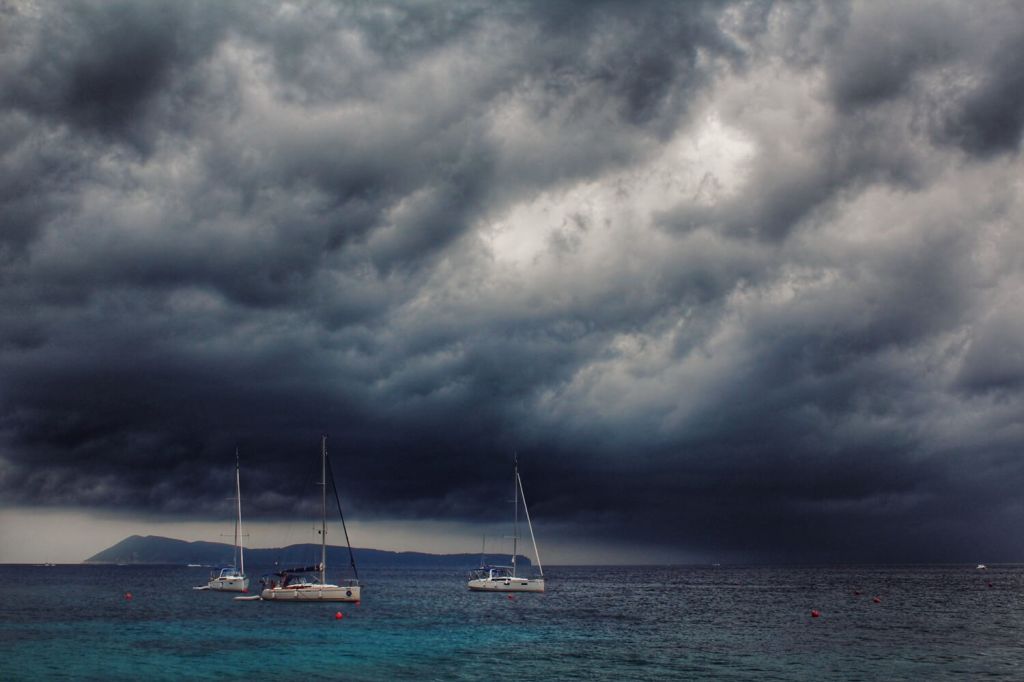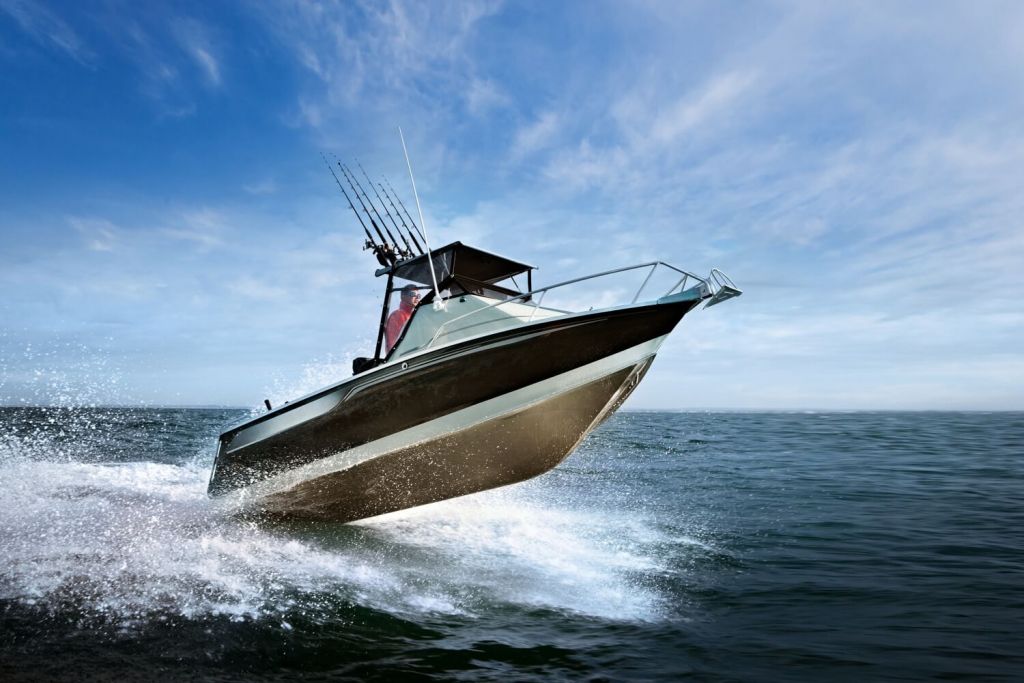What Type of Hull Handles Rough Water the Best?
If you're looking for the right boat hull type for handling rough water, you're in the right place. I've researched boat hulls in detail and in this article, I share what I came up with.
What type of hull handles rough water the best? The displacement hull. Boats with this hull type are, for example, sailboats, canoes, but also trawlers. A displacement hull lies in the water and displaces water when moving. It uses its buoyancy to keep afloat. This makes them more stable in waves. For powerboats, the best rough-water hull is the Deep-V hull.
We'll go into detail on why it handles better below. And I'll also briefly talk about what hull types you definitely want to avoid. And there's one hull you hadn't thought of that beats absolutely everything.

On this page:
The Best Hulls for Rough Waters
There's a one-sided answer to this question and a more nuanced one.
The short answer is the displacement hull. It has been the superior hull design for ages now (literally) for these conditions. Almost all sailboats, cruisers, trawlers and cargo ships use this type of hull. In short, anything that cruises for long periods of time and needs to cross oceans.
However, there are some other hulls to consider. For powerboats, for example, you'll need a type of planing hull that's also steady. For powerboats, the best hull in rough water is the Deep-V hull design.
A good rule of thumb is: the deeper the draft, the better it will handle in rough water.
To get up to speed, here's a quick overview:
| Rank | Hull Type | For what conditions | Notes |
|---|---|---|---|
| 1 | Displacement hull | Ocean cruising | Slow but very steady |
| 2 | Multihulls | Coastal and ocean cruising | Faster, stable, less maneuverable |
| 3 | Semi-displacement hulls | Inland and ocean cruising | Fast and handles well |
| 4 | Deep-V hulls | Coastal and inland | Very fast, with the right design pretty steady in waves |
Displacement Hulls
The displacement hull is definitely the go-to hull for rough water sailing. It's superior in handling rough water. And it has proven to be over many centuries of ocean travel.
That's why it's the most popular hull design for sailboats, canoes, and many trawlers and motorboats.
However, it also has disadvantages. Displacement hulls roll easily, and are quick to capsize. For sailboats, the problem has been fixed by adding a long and heavy keel that stabilizes it.
They also have a maximum hull speed, which means they have an upper speed limit and aren't super fast. (They're slow in modern terms.)
The maximum hull speed for sailboats between 26-36 ft is between 6 - 8 knots. For more information on the maximum hull speed of displacement hulls, and a table of different lengths with their hull speed, you can read my article here.
So while it's a great fit for long term cruising, it isn't a good fit for powerboats that need to go fast.
As you all know, we humans don't like to go slow. So naturally, we've tried to think of faster designs, that also handle well. This gives us a couple of other options. There are hull designs that are A LOT faster, and will still be stable in most conditions. Let's take a look at them.
Other Hull Designs That Are Pretty Stable
- Multihulls - catamarans and trimarans
- Deep-V hulls - modern powerboats
- Semi-displacement hulls - trawlers and cruisers
Multihulls
Simply said, multihulls are just two hulls attached by a deck in between. So you get double the hulls.
Multihulls are displacement hulls with a shallower draft. That means that they lie less deep in the water, which reduces resistance. This makes them faster.
The cool thing about multihulls is that they are incredibly buoyant because of the extra hulls. They are also extremely stable because of the broad base.
They do handle a bit less easy. They are less agile than monohulls and are a bit stiff to handle. (The marine fee is also no joke.)
For a complete list of the most common hull types, please check out my illustrated guide here. It has loads of pictures and really goes into detail on 11 examples.
Semi-Displacement hulls
Semi-displacement hulls are a hybrid between planing hulls and displacement hulls. That means that the boat displaces water, but it can also generate lift at pretty low speeds. You can get trawlers and sailboats with this type of hull. It really increases the top speed of the boat a lot. But it also maintains the steadiness and reliability of regular displacement hulls. That's why it's a very popular hull type for cruising boats that want a little more extra speed.
Deep-V hulls

A Deep-V hull is a type of planing hull. Simply said, a planing hull lies on top of the water, instead of in it. This makes it A LOT faster than displacement hulls, but they also handle poorly in rough water. Even with small waves, most planing hulls will be incredibly bumpy and wet.
The flatter the hull, the faster it will go. But with a totally flat bottom, you can't really steer the thing - it gets a bit like ice skating at high speeds.
Deep-V hulls fix that problem by simply adding a deep wedge shape that runs from bow to stern. This 'Deep-V' cuts through the water, providing the boat with a point of contact with the water. This increases how well it handles dramatically.
With planing hulls, there's a lot to talk about. If you want a more in-depth explanation, you can read my article about planing hulls here.
The absolute best hull type for rough water?
That would be a submarine1.
Why Displacement Hulls Handle So Well in Rough Water
It's beyond the scope of this article, but I wanted to touch on it briefly. Displacement hulls work so well because they have a very low center of gravity, and they use their buoyancy to support their weight. So they lie low in the water. The deeper the draft, the better it handles, since the hull is less affected by waves below the waterline.
What Hull Types Should You Avoid?
There are a couple of boat hulls that are absolutely horrible with even the slightest chop.
- flat-bottomed hulls
- pontoon hulls
Flat-bottomed hulls
I've touched on this briefly before. Flat-bottom hulls handle absolutely terribly with waves. If you want your intestents scrambled and experience the wettest, choppiest ride of your life, take your flat-bottom hull out on the shoreline. It sucks big time.
Pontoon hulls
Pontoon hulls use floaters to lie on top of the water. They are extremely stable, but in waves they handle poorly. The reason is that - like the flat bottoms - they don't have anything helping them cut through the water.
I'd steer clear of this one.
Conclusion
There you have it. Now you know exactly which hull types are good and poor in rough waters. I hope this helps in picking the right one for you, or nailing whatever test you'll be taking!
Footnotes
-
Thanks Buoy Scout at thehulltruth.com for that wonderful joke. ↩
Did you find the answer to your specific question?
👍 10 👎 4
Comments
Grayson Trimble
that is cool!
jim mcclean
exactly what I wanted! short, non too technical and most importantly easily read at one sitting!
Leave a comment